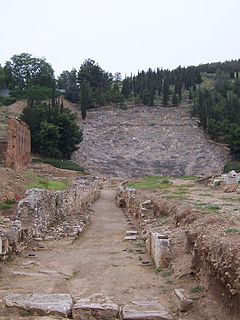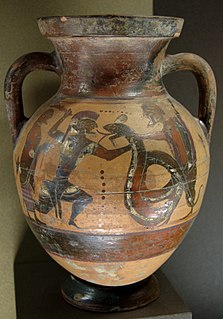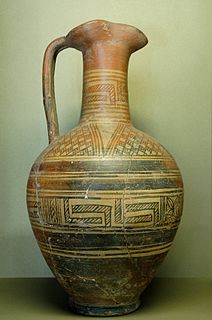
Ancient Greek pottery, due to its relative durability, comprises a large part of the archaeological record of ancient Greece, and since there is so much of it, it has exerted a disproportionately large influence on our understanding of Greek society. The shards of pots discarded or buried in the 1st millennium BC are still the best guide available to understand the customary life and mind of the ancient Greeks. There were several vessels produced locally for everyday and kitchen use, yet finer pottery from regions such as Attica was imported by other civilizations throughout the Mediterranean, such as the Etruscans in Italy. There were various specific regional varieties, such as the South Italian ancient Greek pottery.

Black-figure pottery painting, also known as the black-figure style or black-figure ceramic is one of the styles of painting on antique Greek vases. It was especially common between the 7th and 5th centuries BC, although there are specimens dating as late as the 2nd century BC. Stylistically it can be distinguished from the preceding orientalizing period and the subsequent red-figure pottery style.

Red-figure vase painting is one of the most important styles of figural Greek vase painting.

Lydos was an Attic vase painter in the black-figure style. Active between about 560 and 540 BC, he was the main representative of the '’’Lydos Group’’’. His signature, ό Λυδός, ho Lydos, the Lydian, inscribed on two vases, is informative regarding the cultural background of the artist. Either he immigrated to Athens from the Lydian empire of King Kroisos, or he was born in Athens as the son of Lydian parents. In any case, he learned his trade in Athens.

The Archaeological Museum of Argos is a museum in Argos, in Argolis on the Peloponnese peninsula, Greece. The history of the museum began in April 1932, when the heirs of J. Kallergis donated the building to the Argos city council. They in turn gave it to the Greek state along with the surrounding area on October 25, 1955.

The Analatos Painter was an Attic vase painter of the Early Proto-Attic style.

Boeotian vase painting was a regional style of ancient Greek vase painting. Since the Geometric period, and up to the 4th century BC, the region of Boeotia produced vases with ornamental and figural painted decoration, usually of lesser quality than the vase paintings from other areas.

The term Kabiria Group describes a type of Boeotian vases decorated in the black-figure technique. The term can also be used describe the artists producing vases of the type.

Euboean vase painting was a regional style of ancient Greek vase painting, prevalent on the island of Euboea.

East Greek vase painting was a regional style of ancient Greek vase painting, produced by the eastern Greeks. In spite of the region's wealth, the pottery was rather unremarkable in comparison to other areas. The clay is red-brown to pink and often contains mica inclusions. Many regional sub-styles of East Greek pottery existed.

Rhodian vase painting was a regional style of East Greek vase painting, based on the island of Rhodes.

The Pontic Group is a sub-style of Etruscan black-figure vase painting.

Pseudo-Chalcidian vase painting is an important style of black-figure Greek vase painting, dating to the 6th century BC.
Thessalian vase painting was a regional style of Greek vase painting, prevalent in Thessaly.
Cycladic vase painting was a regional style of Greek vase painting, produced in the Cycladic islands.
Samian vase painting was a regional style of ancient Greek vase painting; it formed part of East Greek vase painting.

Ionic vase painting was regional style of ancient Greek vase painting.

Campanian vase painting is one of the five regional styles of South Italian red-figure vase painting. It forms a close stylistic community with Apulian vase painting.

Klazomenian vase painting was a regional style of ancient Greek vase painting, belonging to the East Greek representations of that form of art.

Paestan vase painting was a style of vase painting associated with Paestum, a Campanian city in Italy founded by Greek colonists. Paestan vase painting is one of five regional styles of South Italian red-figure vase painting.
This page is based on this
Wikipedia article Text is available under the
CC BY-SA 4.0 license; additional terms may apply.
Images, videos and audio are available under their respective licenses.

















